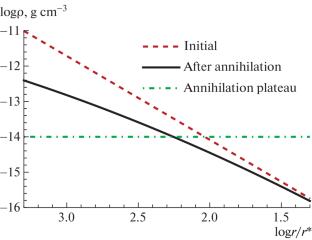原始黑洞周围的暗物质
IF 0.4
4区 物理与天体物理
Q4 PHYSICS, NUCLEAR
引用次数: 0
摘要
巨大的原始黑洞可能在早期宇宙中形成,占暗物质的一小部分。然而,大多数暗物质可能是由基本粒子或质量较小的黑洞组成的。在宇宙演化的辐射主导阶段,这些物体可能在大黑洞周围形成密集的尖峰。暗物质粒子可以在脉冲中湮灭。在本研究中,我们讨论了脉冲的结构和性质,并考虑了它们在湮灭作用下的转变。在涉及不同质量黑洞的混合场景中,小黑洞可以在大黑洞周围的中心区域碰撞并合并。本文章由计算机程序翻译,如有差异,请以英文原文为准。

Dark Matter Around Primordial Black Holes
Massive primordial black holes may have formed in the early universe, accounting for a small fraction of dark matter. Most of dark matter, however, may be composed of elementary particles or black holes with smaller masses. These objects could form dense spikes around the large black holes during the radiation-dominated phase of the universe’s evolution. Dark matter particles can annihilate in the spikes. In this study, we discuss the structure and properties of the spikes, considering their transformation due to annihilation. In the hybrid scenario involving black holes of various masses, small black holes can collide and merge in the central regions around larger black holes.
求助全文
通过发布文献求助,成功后即可免费获取论文全文。
去求助
来源期刊

Physics of Atomic Nuclei
物理-物理:核物理
CiteScore
0.60
自引率
25.00%
发文量
56
审稿时长
3-6 weeks
期刊介绍:
Physics of Atomic Nuclei is a journal that covers experimental and theoretical studies of nuclear physics: nuclear structure, spectra, and properties; radiation, fission, and nuclear reactions induced by photons, leptons, hadrons, and nuclei; fundamental interactions and symmetries; hadrons (with light, strange, charm, and bottom quarks); particle collisions at high and superhigh energies; gauge and unified quantum field theories, quark models, supersymmetry and supergravity, astrophysics and cosmology.
 求助内容:
求助内容: 应助结果提醒方式:
应助结果提醒方式:


